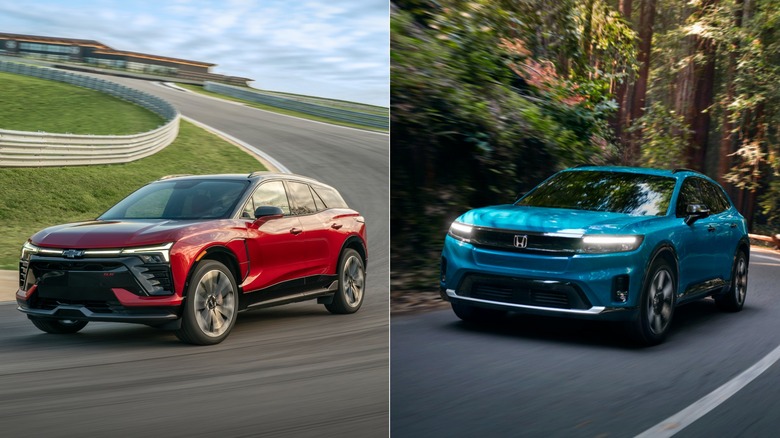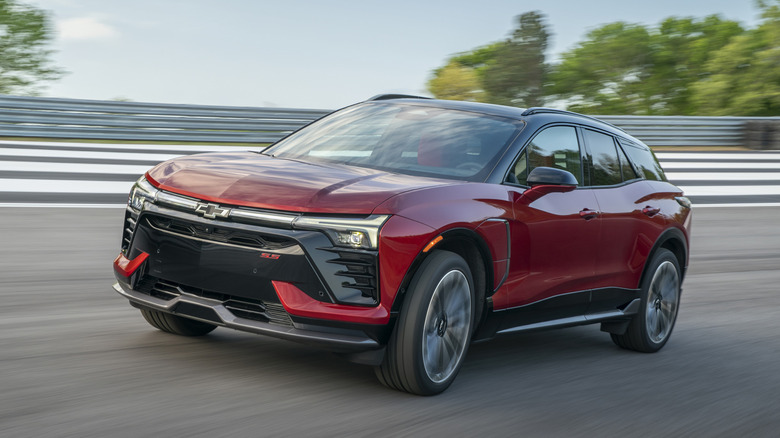What's The GM Equivalent Of The Honda Prologue & How Do Their Prices Compare?
Somewhat surprisingly, the Honda Prologue electric SUV is built on the General Motors-designed Ultium platform. That architecture underpins several electric GM vehicles like the Chevrolet Equinox and the luxurious and feature-rich 2025 Cadillac Lyriq EV. As mentioned, Honda uses the platform to make their Prologue EV, but it's also used as the base for Honda's upscale version — the Acura ZDX. So which GM vehicle is most closely related to the Prologue? It's the Chevrolet Blazer EV. They each have a 121.8-inch wheelbase, use an 85 kWh battery, and provide spacious two-row interiors. Even though they're built on the same platform, these two SUVs are by no means identical. We'll start with the differences in price.
There are three different trim levels of the Honda Prologue: EX, Touring, and Elite. EX and Touring trim Prologues are available in single-motor front-wheel drive or dual-motor all-wheel-drive configurations, while the Touring trim is exclusively equipped with dual motors and all-wheel drive. The base two-wheel drive EX trim has an MSRP of $47,400 (to which you'll have to add a $1,450 destination fee), and all-wheel drive is a $3,000 upgrade. The mid-level Touring trim starts at $53,150 for two-wheel drive, and all-wheel drive costs the same $3,000 extra. The top trim Elite is $10,500 more expensive than the base model with an MSRP of $57,950. The Blazer EV, however, is a bit less pricey; depending on which Blazer EV trim level you go with, you could save a bit of cash up front.
Blazer EV Pricing and specs
The 2025 Chevrolet Blazer EV is available in three trim levels as well: LT, RS, and the new high-performance SS model. In our testing of the 2025 Blazer SS, we found it more impressive on public roads than it was on the track. While the Blazer SS tops the range, the LT is much more affordable. The base price for a front-wheel drive LT model is $46,095, although Chevy charges a $1,495 destination fee. As with the Honda, adding all-wheel drive will cost you an extra $3,000. The mid-level RS trim with front-wheel drive starts at $51,395, but the all-wheel-drive-only SS is a hefty 62,590 before adding any options. The SS does use a larger battery though; a 102 kWh unit that boosts range to 303 miles.
Currently, both the Blazer EV and the Prologue are eligible for the $7,500 federal tax credit, so you'll get a nice chunk back come tax time with either purchase. Equipment is similar between the two models, but there are differences worth noting. Honda, for example, offers wireless Apple CarPlay and Android Auto on all trim levels of the Prologue, but neither can be had in the Blazer EV; GM chose to replace those features with a proprietary smartphone integration system. The Blazer EV offers a few positive trade-offs though, like a massive high-res 17.7-inch center touchscreen (compared to Honda's 11.3-inch panel) and slightly more cargo space behind the rear seats – 59.1 cubic feet compared to Honda's max of 57.7 cubic feet.
There are also power and range differences between the Blazer and Prologue
There are three different range estimates for the Prologue. Front-wheel drive models have an EPA-estimated range of 308 miles. EX and Touring models with all-wheel drive drop down to 294 miles and the Elite trim is the lowest of the bunch at 283 miles of range. While those aren't class-leading numbers, they are adequate for most driving needs. Blazer EV models get better range estimates at the top of the range, but are the same on other trims. Rear-drive RS versions of the Blazer EV offer maximum range with 334 miles between charges – more than any variant of the Prologue. From there, estimates drop down to 312 miles on front- wheel drive models, 303 miles on the SS (despite its larger battery), and 283 miles of range on all-wheel drive variants.
Power also differs between the two models. The Blazer EV has four different power ratings depending on the configuration: front-wheel drive models put out 220 horsepower and 243 lb-ft of torque, with all-wheel drive bumping things up to 300 hp and 355 lb-ft. The rear-drive RS model delivers 365 hp and 325 lb-ft. The Blazer SS tops the power ratings, offering 615 hp and 650 lb-ft of torque with the full-throttle "Wide Open Watts" mode. Maximum power for the Prologue is a modest 300 hp and 355 lb-ft of torque – same as the mid-level AWD Blazer EV. Base trim levels offer the same merely-adequate numbers as the entry-level Chevy at 220 hp and 243 lb-ft.


